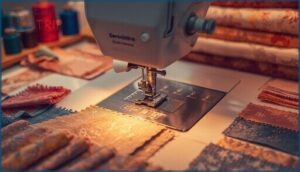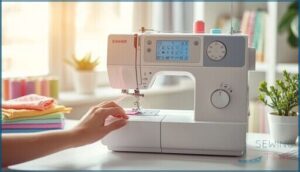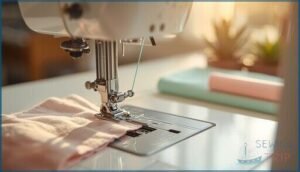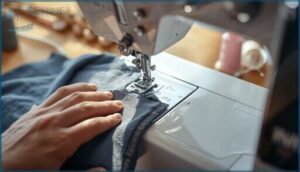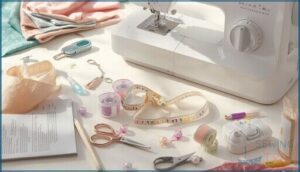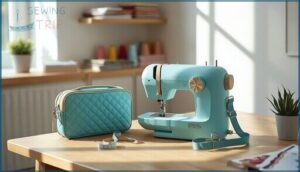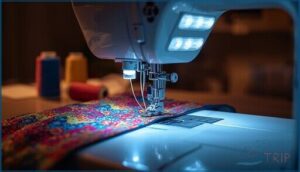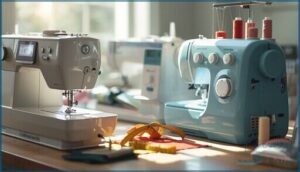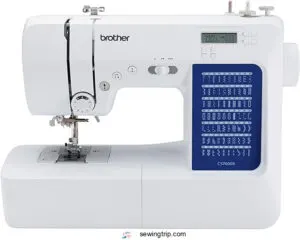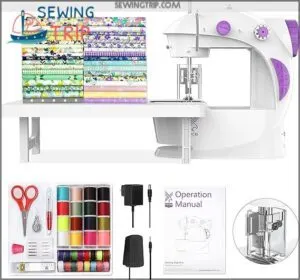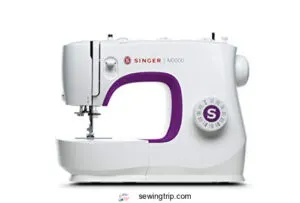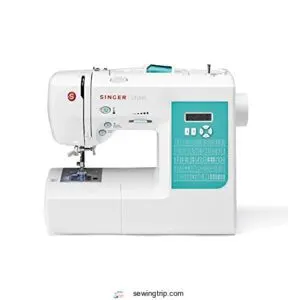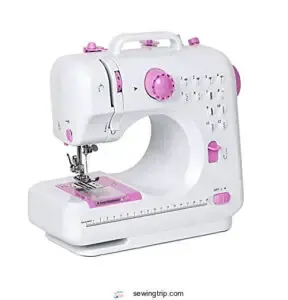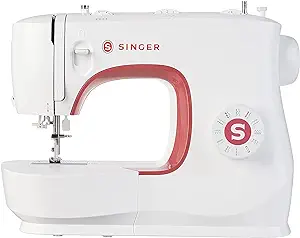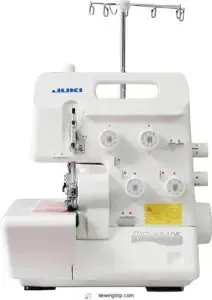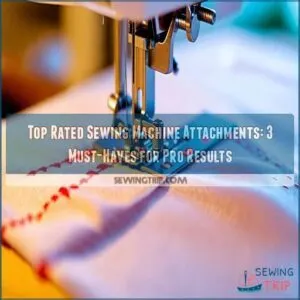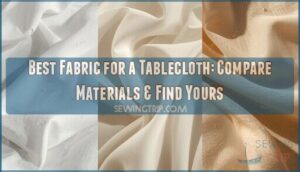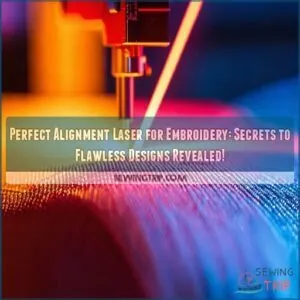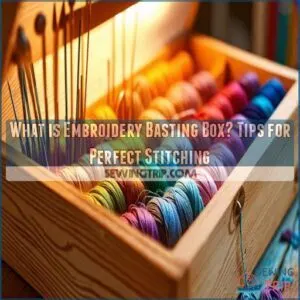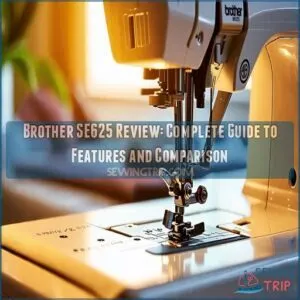This site is supported by our readers. We may earn a commission, at no cost to you, if you purchase through links.
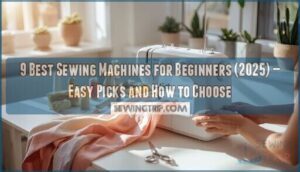
Your first sewing project doesn’t need to end in a tangle of thread and frustration. Many beginners abandon sewing because they start with machines that are either too complex or too cheaply made to handle basic tasks reliably. The right beginner machine strikes a balance—it offers enough features to keep you engaged as your skills grow, but it won’t overwhelm you with bells and whistles you don’t need yet.
Today’s best sewing machines for beginners include automatic threaders, clear stitch guides, and easy-to-use controls that let you focus on learning technique instead of wrestling with equipment.
Whether you’re drawn to garment making, quilting, or simple repairs, the machine you choose will either spark a lifelong creative hobby or collect dust in your closet.
Table Of Contents
- Key Takeaways
- Key Features to Look for in Beginner Sewing Machines
- Types of Sewing Machines for Beginners
- How to Choose The Right Sewing Machine
- Top 9 Best Sewing Machines for Beginners
- 1. Brother CS7000X Sewing and Quilting Machine
- 2. KPCB Tech Mini Sewing Machine Set
- 3. Singer M3500 Sewing Machine with Kit
- 4. Brother Computerized Sewing and Quilting Machine
- 5. Brother SE700 Sewing Embroidery Machine
- 6. Singer Stylist Sewing and Quilting Machine
- 7. NEX Portable Sewing Machine For Children
- 8. SINGER MX231 Sewing Machine Portable
- 9. JUKI Portable Thread Serger Sewing Machine
- Tips for Getting Started With Your First Sewing Machine
- Frequently Asked Questions (FAQs)
- Conclusion
Key Takeaways
- The right beginner machine balances enough features to grow with your skills without overwhelming you, typically costing $150-$300 and including automatic threaders, adjustable stitches, and clear controls that let you focus on technique instead of fighting equipment.
- Look for machines with 10-70 built-in stitches (straight, zigzag, and a few decorative), automatic needle threaders, adjustable speed controls, and LED lighting—these features prevent frustration and help you build confidence through successful early projects.
- Start with simple two-to-four-hour projects like pillowcases or tote bags using forgiving fabrics like cotton, and practice basic stitches on scrap fabric for six to nine months to develop consistent technique and seam accuracy.
- Regular maintenance matters: clean lint from the bobbin case after every few projects, oil moving parts as directed, and get professional servicing every 12-18 months to keep your machine running smoothly and prevent costly repairs.
Key Features to Look for in Beginner Sewing Machines
Choosing your first sewing machine can feel overwhelming with so many options and features out there. To make things easier, it helps to know what details matter most when you’re just starting out.
Here’s what to keep in mind as you look through the most important features for beginners.
Number and Variety of Built-in Stitches
When picking your first machine, the number and variety of built-in stitches can make a world of difference. Look for options that cover essential stitch types—straight, zigzag, and a few decorative stitches. You don’t need dozens; too many can cause stitch overload.
Understanding basic stitch functions is key to mastering your machine. Focus on stitch functionality that encourages project versatility, skill progression, and easy, confident stitch selection from day one.
Ease of Use and User-Friendly Controls
You want a machine that won’t make you feel all thumbs. Start with easy-to-grasp controls—clearly labeled buttons and screens make learning fun, not frustrating. Simplified threading diagrams and top-loading bobbins save time and nerves. Speed adjustment is your secret weapon, and an ergonomic design with enhanced visibility makes every stitch feel like second nature. A good choice has user-friendly tools for beginners.
- Clear controls
- Simplified threading
- Adjustable speed
- Ergonomic build
Automatic Needle Threader and Thread Cutter
Frustration fades fast with Threading Automation like the automatic needle threader found on beginner sewing machines. Pair that with a built-in thread cutter, and you save time at every turn. These features boost User Satisfaction and Cutting Efficiency, making projects smoother.
Regular care keeps performance steady—one small habit that matches these modern sewing machine features and current Market Trends.
Adjustable Stitch Length and Width
With beginner sewing machines, adjustable stitch length and width let you nip fabric puckering in the bud and anchor strong seams. Whether you’re setting basting stitches or fine-tuning for decorative stitching, these adjustments put control in your hands.
- Tweak for quilting adjustments
- Customize seam durability on any fabric
- Easily prevent fabric distortion
- Experiment with decorative patterns confidently
Included Accessories for Beginners
A thoughtfully equipped beginner sewing machine goes beyond the basics: you’ll get several presser foot types, a bobbin variety pack, and a maintenance toolkit for easy upkeep. Educational resources—think printed manuals or online tutorials—make learning less intimidating.
Carrying case options keep things tidy, while accessories like seam rippers and marking tools boost both ease of use and creative confidence in beginner sewing.
Machine Size, Weight, and Portability
A good portable sewing machine should feel as easy to carry as a school backpack. When comparing sewing machine weight and size, focus on:
- Compact design for easy storage.
- Travel machines under 15 pounds.
- Storage solutions like carrying grips.
- Ergonomic features for comfort.
- Portability trends—think classes or small spaces.
Look for options that keep moving and storing simple.
LED Lighting and Visibility Features
When you can’t see your stitches clearly, mistakes multiply fast. LED brightness matters because it reduces eye strain and improves color rendering so you can match threads accurately. Nearly 60% of beginners now prefer LED-lit work areas for better ease of use.
These beginner-friendly sewing machine features use energy efficiency that lasts years, and many models offer upgrade options if you want adjustable lighting later.
Types of Sewing Machines for Beginners
When you’re shopping for your first sewing machine, you’ll quickly notice there are several different types to choose from. Each type has its own strengths and is designed for specific sewing tasks.
Let’s break down the main categories so you can figure out which one fits your needs best.
Mechanical Sewing Machines
Mechanical sewing machines are often called the “old faithful” of beginner-friendly options. They operate with simple dials and manual controls, making you hands-on with every stitch.
These machines account for about 34% of market share because they’re affordable, durable, and straightforward to maintain. With prices between $200 and $500, you’ll find tactile control that builds real sewing skills without overwhelming complexity.
Computerized Sewing Machines
Computerized sewing machines bring automation benefits that simplify your learning curve. With digital interfaces showing stitch patterns on LCD screens, you won’t second-guess your selections. Features like automatic needle threaders and start/stop buttons make ease of use their strongest selling point.
Market trends show these beginner sewing machines now cost $150-$300, offering 10-70 built-in stitches. The portability factor matters too—most weigh under 15 pounds.
Combination Sewing and Embroidery Machines
Think of combination sewing and embroidery machines as your all-in-one creative partner. You’ll get a wealth of sewing machine features—impressive stitch count, embroidery speed up to 1000 SPM, and hundreds of built-in designs.
With larger hoop sizes and automation benefits like touchscreens, beginners can confidently explore both basic sewing and embroidery projects without feeling overwhelmed.
Quilting Machines for Beginners
Beginner quilting machines offer special features that make larger projects easier. You’ll want a machine with throat space around 6.5 inches, giving you room to maneuver fabric for quilting projects. Look for quilting stitch options, specialized quilting foot types, and a reliable fabric feeding system.
With proper quilting machine maintenance and speeds between 600–1,000 stitches per minute, these beginner sewing machines help you tackle quilting confidently without breaking the bank.
Sergers and Overlock Machines
Sergers stand apart from standard sewing machines by using multiple thread systems to create professional-looking seams. Beginner serger machines commonly offer 2-, 3-, or 4-thread options, producing up to 20 distinct stitch types.
While serger threading can feel tricky at first, features like differential feed and clear manuals make these machines approachable. Regular blade maintenance keeps edges crisp on beginner projects.
How to Choose The Right Sewing Machine
Choosing your first sewing machine doesn’t have to feel overwhelming. You just need to think about a few practical things before you buy.
Here’s what to think about so you pick a machine that fits your needs and budget.
Assessing Your Sewing Project Needs
What kind of projects do you want to tackle first? Your answer shapes everything.
If you plan on making tote bags or pillowcases, a basic machine with straight stitches works well. More complex projects like quilting need adjustable stitch length and a larger workspace.
Match your beginner sewing machine features to your skill level and the fabric you’ll use most often.
Setting a Realistic Budget
Once you know your project plans, money matters come next. Setting a realistic budget keeps you from overspending on features you don’t need yet. You can find solid beginner sewing machines between $200 and $350 that last for years.
Here’s what budget-friendly sewing machine shopping looks like:
- Entry-level models generally cost $150 to $300 and cover basic stitching needs
- Financing options break larger payments into manageable monthly amounts
- Starter kits add $20 to $50 for essential tools like thread and needles
- Fabric costs range from $1.50 per meter at thrift stores to $20 at retail shops
Budgeting methods like setting aside 10% of your income for sewing help you plan without guilt. Many sewers find great sewing machine value in lightly used machines from repair shops. Remember that sewing machine affordability isn’t just about the sticker price—factor in ongoing supplies too.
Evaluating Durability and Brand Reputation
When weighing sewing machine durability, start by checking frame materials—metal holds up better than plastic. Motor power matters for bigger jobs, and lower repair costs make a difference over time. Honest user reviews and warranty length clarify long-term reliability.
That’s why testing sewing machines and comparing brands like Brother, Singer, and Janome helps you spot real sewing machine value.
Importance of Clear Manuals and Tutorials
Manual clarity lays the groundwork for a smooth start with any beginner sewing machine. A clear instruction manual or accessible online manual makes threading and troubleshooting feel less like guesswork.
Video sewing tutorials boost confidence and speed up learning, while thorough maintenance guidance in a beginner sewing guide keeps your machine running.
Combine great tutorials with clarity, and user satisfaction quickly follows.
Portability and Storage Considerations
If you often sew in tight spaces or expect to move your beginner sewing machine, keep an eye on machine weight and compact dimensions. Travel cases or built-in storage solutions help make sewing machine portability simpler.
Since space constraints challenge most apartments, choose a portable sewing machine size that tucks easily into shelves, cabinets, or even multipurpose furniture.
Top 9 Best Sewing Machines for Beginners
There’s a sewing machine out there for every beginner, no matter your goals or budget. Nine options that balance ease of use, thoughtful features, and solid value are listed below.
Take a look to see which one might fit your next project best.
1. Brother CS7000X Sewing and Quilting Machine
Ever wondered if one machine can balance Stitch Variety, Beginner Friendliness, and Quilting Features without driving you up the wall? The Brother CS7000X does just that.
It’s a computerized sewing machine packed with 70 stitches and helpful extras—ten presser feet, a broad quilting table, and an LCD for clear controls. Light enough for classes, yet sturdy and smooth on most fabrics, this model remains a hit in user feedback.
For those seeking a reliable, portable beginner sewing machine, it’s a standout choice.
Best For: Beginners and hobbyists who want an easy-to-use, portable sewing machine with lots of built-in features.
- Wide variety of stitches and included accessories for creative projects
- Lightweight and compact, making it travel-friendly and easy to store
- Sews quietly and smoothly, even on tricky fabrics
- Not built for heavy-duty or industrial sewing tasks
- Some users may find threading or certain features tricky at first
- Vibrates a bit at high speeds or on bigger projects
2. KPCB Tech Mini Sewing Machine Set
If you’re after portability benefits and true beginner safety, the KPCB Tech Mini Sewing Machine Set stands out among beginner sewing machines. Its compact size, finger guard, and double-thread design keep things simple—perfect for early beginner sewing projects or young learners.
Just remember, its limited features mean it’s better for light projects like repairs or crafts, not thick fabrics. For those starting out, the set’s value proposition and ease of sewing machine use make it a smart pick for small-scale project suitability.
Best For: Beginners, especially children or anyone looking for a simple, portable sewing machine for light crafting, repairs, or learning the basics.
- Built-in finger guard and easy controls make it genuinely safe and approachable for new users or kids.
- Lightweight and compact, so it’s super easy to move, store, or travel with.
- Comes with a full starter kit and helpful tutorials, making it great value and easy to get started.
- Not suitable for thick fabrics or bigger, more complex sewing projects.
- Durability may be an issue; some users report jamming or wear with frequent use.
- Only offers basic stitch types, so it’s limited if you want more advanced features.
3. Singer M3500 Sewing Machine with Kit
Looking for a sewing machine that meets you where you’re at, but still leaves room as your skills grow? The Singer M3500 Sewing Machine with Kit is a solid choice for beginner-friendly Stitch Applications—32 built-in stitches and a one-step buttonhole make tackling beginner sewing projects a breeze.
You’ll appreciate the automatic needle threader and adjustable stitch width. Its Included Accessories kit, broad Fabric Versatility (from sheer to denim), and strong User Satisfaction in sewing machine reviews make it a reliable companion for any new sewer.
Best For: Beginners and casual sewists seeking a user-friendly, versatile machine with room to grow as their skills improve.
- Easy setup with automatic needle threader and simple controls, ideal for new users
- Handles a wide range of fabrics, from delicate sheers to thick denim
- Includes essential accessories and online resources for a smoother start
- Some users report thread jams and mechanical issues with regular use
- Not designed for heavy-duty or commercial sewing needs
- Manual isn’t included in the box and must be found online
4. Brother Computerized Sewing and Quilting Machine
The Brother Computerized Sewing and Quilting Machine is a smart pick if you want modern automated features without sacrificing simplicity. Its easy threading sewing machine system, LCD display, and wide quilt table help you sew with confidence—even if you’re brand new.
From stitch customization to free-arm quilting performance, this model covers all the bases for beginner sewing machine features.
Reliability and warranty support are strong, plus pricing trends show good value alongside the popular Brother XR3774 Sewing and Quilting Machine.
Best For: Beginners and intermediate sewists looking for an easy-to-use, versatile sewing and quilting machine with helpful modern features.
- 165 built-in stitches, intuitive LCD display, and automatic needle threader for hassle-free setup.
- Wide table and free arm make it ideal for quilting, cuffs, and larger sewing projects.
- Backed by a strong warranty and dependable brand reputation, with plenty of support resources.
- Not designed for commercial or heavy-duty use; build quality has mixed reviews.
- Some users report occasional needle breaks and higher noise levels.
- Warranty may be void if used outside the US or with the wrong voltage.
5. Brother SE700 Sewing Embroidery Machine
If you want embroidery capabilities added to your beginner sewing machine, the Brother SE700 stands out. This embroidery machine blends computerized sewing with a true touchscreen interface, making it easy to use even for first-timers. Wireless connectivity lets you send your embroidery designs straight from your device.
A generous set of included accessories saves time gathering extra tools. Keep in mind the regular maintenance schedule—cleaning after every few hours—which is key to keeping this machine running smoothly.
Best For: Beginners and hobbyists who want to easily create personalized sewing and embroidery projects with built-in designs and wireless convenience.
- Seamlessly combines sewing and embroidery with a large touchscreen and wireless file transfer.
- Includes a wide range of built-in designs, fonts, and accessories for creative flexibility.
- User-friendly setup, auto needle threader, on-screen help, and mobile app support simplify the learning curve.
- Limited 4″ x 4″ embroidery field restricts larger projects and quilts.
- Additional purchases like thread, stabilizer, or app subscriptions may be required.
- Some users report unclear instructions and occasional machine wobble or squeaks.
6. Singer Stylist Sewing and Quilting Machine
Now, if you’re drawn to a sewing machine with a broad Stylists Stitch Variety and reliable quilting capabilities, the Singer Stylist stands out. Beginners often praise its ease of use and clear controls, making it less intimidating when you’re learning.
Machine durability is another bright spot—the metal frame inside really helps it hold up through years of projects. With strong market performance and positive reviews, this beginner sewing machine balances features and value. You’ll get both creative flexibility and steady reliability in one package.
Best For: Beginners and hobbyists who want a user-friendly sewing machine with lots of stitch options and reliable quilting features.
- Intuitive controls and simple threading make it accessible for newcomers.
- 100 built-in stitches and 10 presser feet offer great creative flexibility.
- Durable metal frame and long warranty support years of projects.
- Some plastic parts, including the presser foot handle, may wear out with frequent use.
- Bobbin loading system takes a bit of practice to master.
- Power supply is limited to North America only.
7. NEX Portable Sewing Machine For Children
If you’re introducing sewing to a young beginner, the NEX Portable Sewing Machine checks all the right boxes for child safety and portability benefits. It’s light, easy to use, and runs on batteries—just right for small hands or crowded tables.
The 12 built-in stitches keep things simple, though the stitch limitations mean it’s best for basic projects like masks or doll clothes. Expect a gentle learning curve and good project suitability for ages 6–12 (with adult supervision, of course).
Best For: Kids and total beginners looking for a simple, portable sewing machine for small projects and crafts.
- Lightweight and easy for children to handle or store.
- Runs on batteries or AC, so it’s good for travel or crowded spaces.
- Affordable, with 12 stitch options for basic sewing and mending.
- Not strong enough for thick or heavy fabrics.
- Instructions can be tricky, especially for first-time users.
- Occasional issues with thread tangling or the foot pedal.
8. SINGER MX231 Sewing Machine Portable
For beginner sewing machines, the SINGER MX231 stands out for its balance of portability benefits, straightforward controls, and sturdy performance. With 23 built-in stitches and a full suite of 97 stitch applications, you’ll have plenty of creative room—whether you’re hemming jeans or tackling basic crafts.
The front-load bobbin and built-in needle threader simplify setup, while thoughtful accessory support helps new users hit the ground running. Its light weight and durable build make it easy to move and reliable for daily use.
Best For: Beginners or crafters wanting a simple, portable sewing machine that works well for everyday projects and a range of fabrics.
- Easy to carry and store thanks to its lightweight frame and carrying handle.
- Versatile selection of 23 stitches and 97 stitch applications covers most household and craft needs.
- User-friendly features like the built-in needle threader and clear LED light simplify setup and use.
- The front-load bobbin system can jam if not loaded carefully, especially for new users.
- Limited to 23 built-in stitches, which may not satisfy advanced or specialized sewing needs.
- Stitch selection and adjustments are manual, which might take time for absolute beginners to master.
9. JUKI Portable Thread Serger Sewing Machine
If you’re eyeing sergers for your lineup of beginner sewing machines, the JUKI Portable Thread Serger sets itself apart. It’s easy to use thanks to its color-coded Threading System, while the Stitch Versatility lets you handle everything from t-shirts to home décor.
Speed Control is smooth and responsive—you’ll finish projects quickly. Its Portability Design means you can tuck it away or travel with it.
Given its Market Value and sturdy build, it’s a solid investment for beginners wanting professional results.
Best For: Beginners and home sewists looking for a speedy, easy-to-use serger with professional results.
- Super easy color-coded threading and quick setup
- Stitches look polished even on tricky fabrics
- Light, compact, and simple to move or store
- No coverstitch or coverhem functions
- Manual lacks some stitch detail—extra research may be needed
- Accessories and cleaning tools often sold separately
Tips for Getting Started With Your First Sewing Machine
Starting with a new sewing machine can feel a little overwhelming, but it doesn’t have to be. A few simple steps will help you get comfortable and ready to sew.
Here’s what you’ll want to know as you get started.
Setting Up and Threading Your Machine
Setting up and threading your sewing machine might feel like solving a puzzle at first, but it’s easier than you think. Most modern machines include automatic needle threaders that cut threading time by half. Here’s what to focus on:
- Threading Paths: Follow the numbered guide on your machine carefully
- Bobbin Winding: Wind evenly to prevent tension issues and thread tangles
- Pre-Sewing Checks: Verify needle type, thread path, and tension adjustment before starting
Practicing Basic Stitches and Controls
Stitch consistency takes time—most beginners need six to nine months of regular practice to see real improvement. Start by sewing along marked lines on scrap fabric to build fabric handling skills.
Focus on speed control; sewing too fast causes jams and uneven seams. Practice seam accuracy by following seam allowance guides.
Beginner-friendly machines with varied stitch options make exercise frequency easier and more enjoyable.
Choosing Simple Beginner Sewing Projects
You’ll build confidence faster with projects that wrap up in two to four hours. Pillowcases, tote bags, and elastic waist skirts rank high as beginner sewing projects—they feature straight seams and forgiving fabrics like cotton.
Pattern clarity importance can’t be overstated; look for step-by-step instructions with photos. These quick wins matter because they keep you motivated while developing essential sewing skills without overwhelming you.
Maintaining and Cleaning Your Sewing Machine
Think of your machine like a car—it won’t run smoothly without regular care. Cleaning frequency matters: brush out lint from critical areas like the bobbin case after every few projects.
Lubrication benefits include quieter operation and less wear. Professional servicing once a year catches what you might miss.
A basic lint brush and sewing machine troubleshooting skills prevent most user errors before repair tools become necessary.
Frequently Asked Questions (FAQs)
How often should a sewing machine be serviced for maintenance?
Like tuning up a car, your sewing machine needs servicing every 12-18 months.
Usage intensity and material types affect this timeline—heavy fabrics demand more frequent attention to prevent failure and maintain peak performance.
What are the key parts to maintain in a sewing machine?
You should maintain the needle, bobbin case, tension system, shuttle hook, and feed dogs. Regular oiling keeps parts moving smoothly.
Proper threading and tension adjustments guarantee great stitch quality every time.
How do you adjust the bobbin tension in a sewing machine?
Getting tension right makes the difference between professional stitches and frustrating tangles.
Turn the bobbin case screw clockwise to tighten or counterclockwise to loosen, testing on scrap fabric after each small adjustment.
How much should I spend on my first machine?
Budget expectations for entry-level sewing machines range from $150 to $ Feature prioritization and brand value matter—budget-friendly sewing machines with bundles offer better long-term costs, balancing sewing machine affordability with durability.
Can I sew denim or thick fabrics as a beginner?
Yes, you can sew denim and thicker fabrics as a beginner. Use a heavy-duty sewing machine with a strong motor, proper needle size guide (90/14 or larger), and polyester thread for best results.
Do I need special thread for different fabrics?
Yes. Thread fiber types must match fabric weight and seam strength needs. Cotton works for natural fabrics, while polyester suits synthetics and stretches.
Specialized thread applications prevent breakage and guarantee proper tension during weaving.
Whats the difference between bobbins and spools?
A bobbin holds the lower thread beneath the needle plate, while a spool sits on top and feeds the upper thread. Both work together during threading, with spool caps preventing tangling.
Should I take a sewing class before buying a machine?
Taking a sewing class before buying your machine helps beginner sewers understand essential features, prevents costly repair mistakes, and accelerates skill acquisition.
Classes boost confidence while improving long-term satisfaction retention for learning to sew.
Conclusion
Like Dorothy discovering she’d the power to go home all along, you already have what it takes to sew—you just need the right machine to begin.
The best sewing machines for beginners won’t do the work for you, but they’ll remove the obstacles that make learning feel impossible.
Start with one that matches your goals, practice on simple projects, and trust that each stitch brings you closer to the maker you’re becoming.
- https://www.singer.com/collections/beginner-sewing-machines
- https://blog.closetcorepatterns.com/buying-your-first-sewing-machine
- https://www.reddit.com/r/SewingForBeginners/comments/1bqilpf/what_are_the_features_in_a_sewing_machine_that
- https://www.brother-usa.com/home/sewing-embroidery/beginner-sewing-machines?srsltid=AfmBOor9NfVDCcTjzklFY_kMfUDNuYxwqc-Wm0CbK91ALPFUHVt_Z901
- https://sewcanshe.com/7-best-sewing-machines-for-a-beginner

